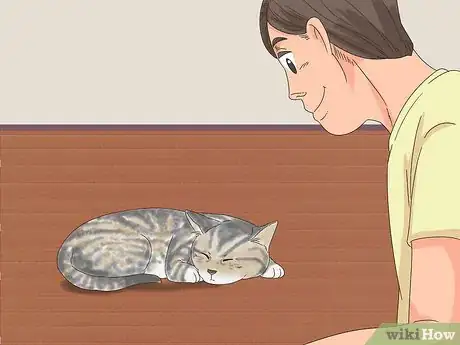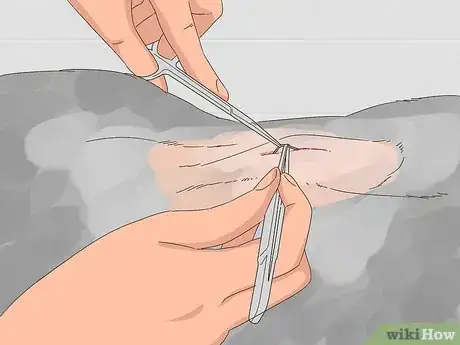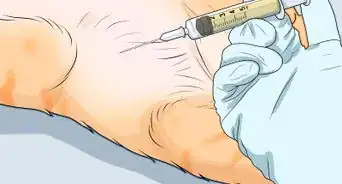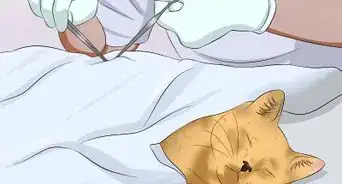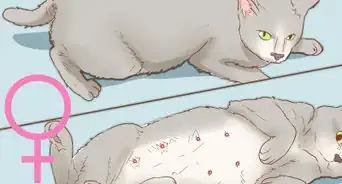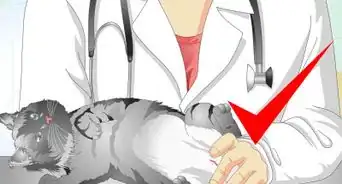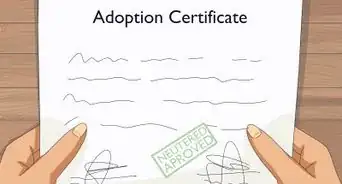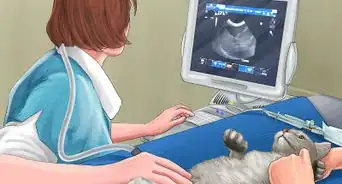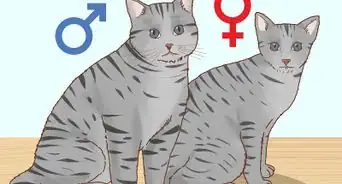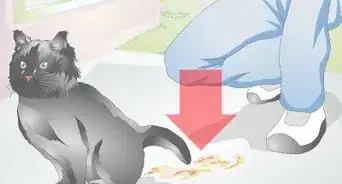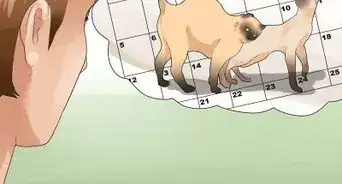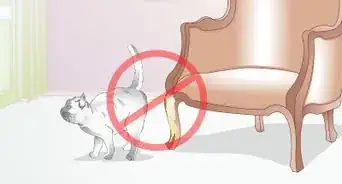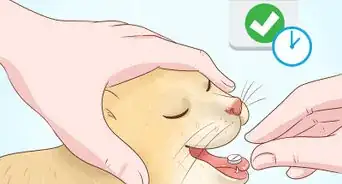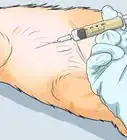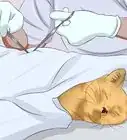This article was co-authored by Natalie Punt, DVM. Dr. Natalie Punt is a Veterinarian and the Founder and CEO of mPet- a smart phone app for pet owners to store, manage and transfer their pets medical records and health information. She specializes in small animal emergency and general medicine and veterinary practice economics. Dr. Punt holds a BS in Biochemistry and Molecular Biology from The University of California, Davis, an MS in Biochemistry from The University at Buffalo, and a DVM from Western University of Health Sciences.
This article has been viewed 16,688 times.
A Cesarean section (or c-section) is a surgical procedure whereby kittens are removed from a cat's uterus (when natural kittening difficult for some reason). Most cats can recovery quickly from c-section surgery, but they will need some additional care after they come home. By ensuring adequate rest, feeding your cat properly, and understand when to see a vet, you can help your cat recovery safely.
Steps
Ensuring Proper Rest
-
1Keep her indoors for at least two weeks. In order for your cat to get adequate rest (and to prevent infection), it is important for her to stay indoors (where you can keep an eye on her) for at least two weeks. Close any open cat-doors, and keep your cat inside. Make sure to have a litter box nearby so your cat can relieve herself without needing to go outside.[1]
-
2Make accommodations. A c-section is an invasive surgery. Your cat will have staples or stitches, and she will be very sore. Strenuous activity like jumping could cause a ligature to slip or inflame her wound, so discourage her from jumping or climbing stairs for a while by placing obstacles on high perches she likes to sit on. Ensure that everything your cat needs remains on one floor of your house, and make sure she can easily access all amenities. You may want to:
- Relocate food and water bowls.
- Relocate litter boxes.
Advertisement -
3Monitor her closely. During the first few hours after your cat returns home, keep a close eye on her. She may still be drowsy and weak, and could fall and hurt herself (or one of the kittens). Kittens should not be left alone with her until she is fully revived, able to stand on her own without stumbling, and shows an interest in taking care of them.[2]
- Until the mother cat is ready to care for the babies, ensure that they are kept warm.
- Place them in a box with a blanket. If your house is especially cold, you can include a heating pad on a low setting.
Feeding Your Cat Post-Caesarean
-
1Offer small amounts of food every 15-30 minutes. After your cat returns home, she needs to eat to regain her strength. However, if she eats too much too quickly right after the anesthetic, she is likely to vomit. As such, you should offer her small amounts of food (1/4 cup [59 ml] at a time or less), frequently (every 15-30 minutes). Her food intake in the first few days post-Cesarean should be about 1.5 times what she ate before she became pregnant.[3]
-
2Feed her high-quality kitten food. If your cat is nursing her kittens, it is important for her to consume the right food. She should be eating kitten formula food of a high-quality brand. Speak to your vet about which food they recommend for nursing mothers.[4]
-
3Gradually increase her food intake. If your cat is keeping her food down, begin to gradually increase the amount of food she eats. By the third or forth week after her c-section, she should be consuming 2 to 2.5 times what she ate before becoming pregnant, depending on how many kittens she’s nursing.[5]
-
4Make sure the kittens are eating. Newborn kittens will need to nurse almost immediately. As soon as the mother cat is awake and aware, you can help her begin to nurse. Help the mother to lay still and line the kittens up to her teats. You can also give the teats a little squeeze to express some milk, which should encourage the babies to begin nursing.[6]
- Depending on the nature of your mother cat's recovery, your vet may recommend supplementing the kittens with kitten formula until the mother cat is ready to nurse.
Understanding When to See a Vet
-
1Take her temperature. If your cat seems unusually warm, you can take her temperature to check for fever. Between 100.5 and 102.5 degrees F (38.1 to 39.2 degrees C) is considered normal for a cat. Your cat's temperature may rise 1-2 degrees F (0.5 - 1 degrees C) above normal for the first 1-3 days. If it has been longer than three days, or if your cat's temperature rises above 104. degrees F (40 degrees C), it is time to consult your vet.[7]
- Never give your cat acetaminophen or aspirin. These medications are toxic for cats.
-
2Monitor vaginal discharge. For the first week after your cat gives birth, a bloody vaginal discharge is to be expected. This discharge will be heaviest for the first three days, and then begin to taper off. If the vaginal discharge continues for more than a week, changes color, or develops an odor, seek the advice of your vet.[8]
- If your cat was spayed at the time of the c-section, there may be no discharge at all.
-
3Look at her incision. Your cat's incision should be examined daily for signs of excessive swelling, redness, or discharge. Wash your hands before touching your cat, and avoid touching the incision itself.[9]
-
4Have stitches or staples removed. Depending on the type of material that was used, your cat's stitches or staples may or may not need to be removed. In general, any staples and any visible stitches will need to be removed 10-14 days after the procedure. If you cannot see the stitches, they are most likely absorbable, and will not need to be removed. Discuss these details with your vet.[10]
-
5Listen for whimpering kittens. Young kittens should be nursing or sleeping almost all of the time. Although they will occasionally whimper, they should not cry much. If you notice the kittens crying often, or for long period of time, check that they’re warm enough and have been fed recently. If they continue crying, contact your vet immediately. Excessive whimpering could be a sign of inadequate milk or other milk-related problems that could be ultimately fatal to baby kittens if not recognized and corrected.[11]
Expert Q&A
-
QuestionCan I let my kittens be with their mother when she got surgery the day before?
 Pippa Elliott, MRCVSDr. Elliott, BVMS, MRCVS is a veterinarian with over 30 years of experience in veterinary surgery and companion animal practice. She graduated from the University of Glasgow in 1987 with a degree in veterinary medicine and surgery. She has worked at the same animal clinic in her hometown for over 20 years.
Pippa Elliott, MRCVSDr. Elliott, BVMS, MRCVS is a veterinarian with over 30 years of experience in veterinary surgery and companion animal practice. She graduated from the University of Glasgow in 1987 with a degree in veterinary medicine and surgery. She has worked at the same animal clinic in her hometown for over 20 years.
Veterinarian Yes! In fact, the kittens suckling from the mother will help her recovery. Just make sure she has milk for the kittens and you don't need to supplement with kitten milk replacer. Also, keep checking her wound to make sure it is not sore and that the kittens have not scratched it.
Yes! In fact, the kittens suckling from the mother will help her recovery. Just make sure she has milk for the kittens and you don't need to supplement with kitten milk replacer. Also, keep checking her wound to make sure it is not sore and that the kittens have not scratched it.
References
- ↑ http://www.petplace.com/article/cats/diseases-conditions-of-cats/surgeries/c-section-cesarean-in-cats
- ↑ https://vcahospitals.com/know-your-pet/caesarean-sections-in-cats-post-operative-instructions
- ↑ https://vcahospitals.com/know-your-pet/caesarean-sections-in-cats-post-operative-instructions
- ↑ https://vcahospitals.com/know-your-pet/caesarean-sections-in-cats-post-operative-instructions
- ↑ https://vcahospitals.com/know-your-pet/caesarean-sections-in-cats-post-operative-instructions
- ↑ https://vcahospitals.com/know-your-pet/caesarean-sections-in-cats-post-operative-instructions
- ↑ https://vcahospitals.com/know-your-pet/caesarean-sections-in-cats-post-operative-instructions
- ↑ https://vcahospitals.com/know-your-pet/caesarean-sections-in-cats-post-operative-instructions
- ↑ http://www.petplace.com/article/cats/diseases-conditions-of-cats/surgeries/c-section-cesarean-in-cats
About This Article
To care for your cat post-caesarean section, make sure to keep it indoors for at least 2 weeks so it gets the rest it needs to heal. Because your cat will be sore, you should make sure your its food, water, and litter boxes are on the the same floor, so it can easily reach them. If your cat is having trouble keeping food down after the surgery, try offering it small amounts of food every 15-30 minutes so it doesn’t throw up. Additionally, if your cat is nursing its kittens, make sure you’re feeding it kitten formula so both mom and the little ones get the nutrition they need. To learn how to check your cat’s incision for signs of infection, read more from our Veterinary co-author.


